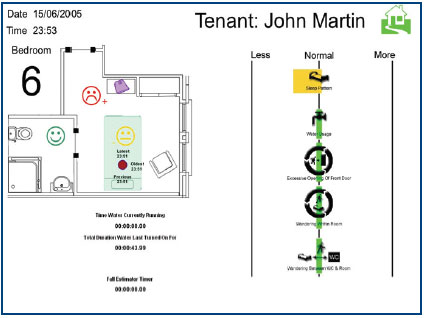Demographic trends inform us that Europe will experience a sustained increase in the ageing population. The needs of this population cohort place a huge financial, medical and social care burden on the relevant agencies, and there is a growing desire to move towards an infrastructure which offers people an increased level of autonomy and improved quality of life within their own living environments. A Smart Home environment offers the potential for persons to remain in their own homes for a longer period of time, prior to the need to move to a residential healthcare facility. Provision of this need has been facilitated with the evolution of computing to a new era of ubiquitous computing, which envisages people being immersed in an environment with many supporting processors, sensors and actuators. However, while these new devices will be complex to design and configure, they will need to be usable and useful if they are to be adopted widely by people. The management of this complexity and its implementation in the form of non-intrusive and user-friendly devices provides a challenge for technologies that support independent living, particularly for the ageing and for people with disabilities.
 The University of Ulster has recently embarked on a collaboration with the Dundalk Institute of Technology in the Nestling Technologies Project. This initiative is a collaborative venture in the North-east of Ireland which aims to provide environments that promote and sustain independence and well-being for older people through the fusion of innovative spatial, technology and integrated community care-based approaches. This will be achieved over a five year period by the development of an integrated care demonstration model in Dundalk (12 homes); the building of capability through evidence development, awareness and continuous process improvement; and developing a business model for sustainable, continued growth.
The University of Ulster has recently embarked on a collaboration with the Dundalk Institute of Technology in the Nestling Technologies Project. This initiative is a collaborative venture in the North-east of Ireland which aims to provide environments that promote and sustain independence and well-being for older people through the fusion of innovative spatial, technology and integrated community care-based approaches. This will be achieved over a five year period by the development of an integrated care demonstration model in Dundalk (12 homes); the building of capability through evidence development, awareness and continuous process improvement; and developing a business model for sustainable, continued growth.
For further details please contact
Dr Chris Nugent
([email protected]
) or Maurice
Mulvenna
([email protected]
) , or Jonathan
Wallace,
School of Computing and Mathematics, Faculty of Engineering,
University of Ulster, Jordanstown, Shore Road, Newtownabbey, Co Antrim, Northern Ireland, BT37 0QB.
|

